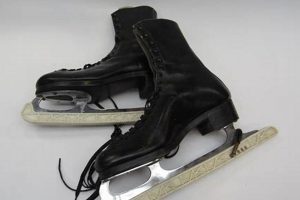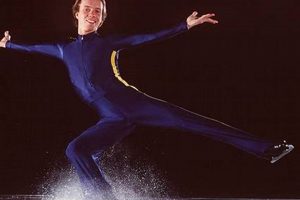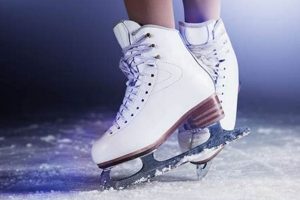Determining the appropriate size for ice skates is crucial for both performance and comfort. Ill-fitting skates can lead to discomfort, blisters, and reduced control on the ice. The perception that ice skates fit differently than street shoes is common, leading to the frequent question regarding whether they tend to be larger or smaller than expected.
Properly sized ice skates enhance a skater’s ability to execute maneuvers and maintain balance. Historically, skaters relied on experience and the advice of specialized retailers to achieve the correct fit. The consequences of improper sizing range from mild inconvenience to an increased risk of injury. Understanding the nuances of skate sizing improves the overall skating experience and contributes to safer participation in the sport.
The following sections will delve into the factors influencing ice skate sizing, explore brand-specific sizing variations, and provide guidance on accurately measuring foot size to select the optimal skate size. Ultimately, this will help skaters make informed decisions regarding their equipment.
Tips for Determining the Appropriate Ice Skate Size
Selecting the correct ice skate size necessitates careful consideration. The following tips outline key factors that impact fit and comfort.
Tip 1: Consult Brand-Specific Size Charts: Sizing varies significantly between different ice skate manufacturers. Always refer to the brand’s specific size chart, often available on their website or at retailers, before making a purchase.
Tip 2: Accurately Measure Foot Length and Width: Use a Brannock device or a ruler and piece of paper to measure the foot’s length and width. Measurements should be taken while standing with weight evenly distributed.
Tip 3: Consider Sock Thickness: The type of socks worn during skating impacts the fit. When measuring the foot, wear the same type of socks intended for use with the skates. This will ensure an accurate measurement that accounts for sock thickness.
Tip 4: Try Skates on in a Skating Stance: After putting on the skates, simulate a skating stance by bending the knees slightly. This position shifts the foot within the skate and can reveal pressure points or areas of discomfort not apparent when standing upright.
Tip 5: Assess Toe Clearance: When standing upright in the skates, the toes should lightly brush the end of the skate. When in a skating stance, the toes should pull back slightly from the end, allowing for movement and preventing toe bang.
Tip 6: Evaluate Heel Lock: A proper fit ensures the heel remains firmly in place within the skate. Excessive heel movement can lead to blisters and reduced control. A well-fitted skate provides a secure heel lock.
Tip 7: Seek Professional Assistance: Consult with experienced skate fitters at reputable sporting goods stores or ice rinks. Their expertise can be invaluable in determining the optimal skate size and model for individual needs and foot characteristics.
Implementing these tips maximizes the likelihood of selecting ice skates that provide both comfort and performance. By prioritizing accurate measurement and careful consideration of individual factors, skaters can avoid common sizing pitfalls and enjoy a more comfortable and controlled skating experience.
The subsequent section will address common misconceptions surrounding ice skate sizing and provide a framework for resolving fitting issues.
1. Brand-specific sizing
Brand-specific sizing plays a pivotal role in addressing the common question of whether ice skates generally fit larger or smaller than standard shoe sizes. The inconsistencies in sizing conventions across different manufacturers necessitate a nuanced understanding to ensure optimal fit and performance.
- Varying Internal Dimensions
Each brand employs distinct molds and manufacturing processes, resulting in variations in the internal dimensions of their ice skates. These variations directly impact the fit, with some brands consistently running larger or smaller than others, even when labeled with the same nominal size. A skater who wears a size 8 in one brand may require a size 7.5 or 8.5 in another.
- Length and Width Discrepancies
Beyond overall length, brands also differ in the width of their skates. A skate labeled as a “D” width in one brand might feel narrower or wider than a “D” width in another. Skaters with particularly wide or narrow feet must be especially attentive to these discrepancies, as a poorly matched width can lead to discomfort and reduced performance.
- Targeted Foot Morphology
Some brands design their skates to accommodate specific foot shapes and morphologies. For example, a brand might cater to skaters with high arches or wider forefeet. Understanding a brand’s design philosophy helps skaters identify models that are inherently more likely to provide a comfortable and secure fit. This focus on specific foot characteristics influences how skates from different brands compare in size.
- Model-Specific Variations
Even within a single brand, sizing can vary between different skate models. High-end performance skates often feature a tighter, more anatomical fit than recreational models. Skaters should not assume that the sizing of one model will translate directly to another, even within the same brand. Always consult the brand’s size chart and, ideally, try on multiple models to determine the best fit.
The inconsistencies arising from brand-specific sizing highlight the importance of relying on more than just a skater’s street shoe size when selecting ice skates. Accurate foot measurements, coupled with a thorough understanding of each brand’s sizing tendencies and design philosophy, are essential for mitigating the inherent challenges posed by varying sizing standards. The perception of whether “ice skates run big or small” is heavily influenced by these brand-specific nuances, making a generalized answer impossible.
2. Foot measurement accuracy
The accuracy of foot measurements is paramount when determining the appropriate ice skate size and addressing the common question of whether ice skates tend to run large or small. Precise measurements serve as the foundation for informed skate selection, mitigating the risk of ill-fitting skates and associated performance detriments.
- Standardization Challenges
While foot length is typically measured in inches or centimeters, the correlation between these measurements and ice skate sizes is not standardized across manufacturers. A foot measuring precisely 27 centimeters may correspond to a size 9 in one brand and a size 8.5 or 9.5 in another. Accurate measurement provides a baseline, but brand-specific size charts must be consulted to translate foot length into an appropriate skate size. Failing to account for these variations undermines the value of accurate measurement.
- Foot Width Considerations
Foot width is an equally critical dimension, often overlooked in favor of length. Inadequate width accommodation results in discomfort, numbness, and impaired circulation. Standard width designations (e.g., D, EE) vary in actual dimensions between brands. Accurate width measurement, often achievable with a Brannock device, allows skaters to identify skate models that match their foot’s profile, preventing the perception of skates running too narrow and consequently feeling “small.”
- Measurement Technique Influence
The method of measurement significantly impacts accuracy. Measurements taken while sitting or with weight unevenly distributed are prone to error. The foot should be measured while standing, with weight evenly distributed across both feet. Furthermore, the use of calibrated measuring devices and adherence to standardized measurement protocols minimizes variability and enhances reliability. Inconsistent technique introduces inaccuracies that compromise the effectiveness of the measurement in determining appropriate skate size.
- Dynamic Foot Changes
The foot’s dimensions can change throughout the day due to swelling and other physiological factors. Measurements taken in the morning may differ from those taken in the evening. For optimal accuracy, foot measurements should be taken at the end of the day, when the foot is at its largest. This ensures that the selected skate size accommodates potential fluctuations in foot volume, preventing the sensation of skates feeling “small” due to daily variations.
Ultimately, accurate foot measurement serves as a necessary, but not sufficient, condition for proper skate sizing. While precise measurements provide a reliable starting point, they must be combined with brand-specific size chart consultations and, ideally, in-person skate fittings to account for the complexities of skate construction and individual foot characteristics. Accurate foot measurement reduces the likelihood of selecting skates that are clearly too large or too small, but it does not eliminate the need for further refinement in the fitting process.
3. Sock thickness impact
Sock thickness significantly influences the perception of whether ice skates fit larger or smaller than expected. The volume occupied by socks within the skate boot directly alters the available space for the foot. Thicker socks reduce the internal volume, potentially making skates feel smaller, while thinner socks increase the volume, potentially making skates feel larger. This effect is particularly pronounced in skates designed for a snug, performance-oriented fit. For example, a skater who typically wears thin socks may find that their usual skate size feels restrictive when wearing thicker athletic socks, leading to the incorrect conclusion that the skates inherently run small. The converse is also true; if one usually skates with thick socks and tries thinner ones, it may feel as if the skates are too big.
The type of sock material also contributes to the overall fit. Cotton socks, for instance, tend to absorb moisture and compress over time, potentially altering their thickness and influencing the skate’s perceived fit throughout a skating session. In contrast, moisture-wicking synthetic socks maintain their shape and thickness more consistently, providing a more stable fit. The compression characteristics of different sock materials impact the available space within the skate boot and, consequently, the accuracy of initial sizing assessments. Ignoring the sock material’s properties can lead to discomfort and compromised performance. For example, the use of cotton socks in a properly fitted skate can cause the foot to swell as the sock absorbs moisture, creating pressure points and leading to the perception that the skate is too small after a period of skating.
In summary, sock thickness and material composition represent critical variables in determining the effective fit of ice skates. Selecting appropriate socks, similar in thickness and material to those used during the initial skate fitting, is essential for maintaining consistent comfort and performance. Disregarding the impact of sock thickness can result in inaccurate sizing assessments, leading to the common misperception that skates inherently run larger or smaller than true-to-size. Therefore, accounting for sock-related factors is crucial for achieving an optimal skate fit.
4. Skating stance fit
The fit of ice skates in a skating stance is crucial to accurately determining the appropriate size, directly influencing the perception of whether skates run big or small. A static fit assessment, performed while standing upright, often fails to reveal subtle yet significant discrepancies that become apparent under the dynamic conditions of skating. The nuances of the skating stance require careful consideration to ensure optimal comfort and performance.
- Ankle Flexion and Forward Lean
The skating stance involves significant ankle flexion and a forward lean, which alters the position of the foot within the skate boot. This forward movement shifts the foot, potentially creating pressure points at the toes or instep if the skate is too small. Conversely, excessive space may become evident in the heel or ankle area if the skate is too large. This dynamic fit can significantly differ from the initial static assessment, revealing a need for adjustments in size or lacing technique. For example, a skater may find that a skate which felt comfortable while standing upright now feels constricting across the toes when in a full skating crouch, indicating that a slightly larger size may be necessary.
- Heel Lift and Blister Formation
An inadequate heel lock in the skating stance increases the risk of heel lift, leading to friction and potential blister formation. The repetitive motion of skating exacerbates this issue, making a secure heel fit essential. A skate that feels marginally large while standing may exhibit pronounced heel lift during skating, creating discomfort and hindering control. Conversely, a skate that is too tight may restrict ankle movement, causing chafing and discomfort along the Achilles tendon. Addressing heel lift often necessitates adjustments to lacing patterns or the use of heel inserts to achieve a more secure and comfortable fit.
- Toe Clearance and Toe Bang
Sufficient toe clearance is vital to prevent “toe bang,” where the toes repeatedly strike the front of the skate during forward strides or stops. While a slight brushing of the toes against the front of the skate is acceptable when standing upright, the toes should have adequate space when in a skating stance to avoid impact. A skate that feels appropriately sized in a static position may prove too small once the foot is flexed forward during skating. Ensuring adequate toe clearance requires assessing the fit while simulating skating movements, allowing for adjustments to skate size or boot selection.
- Arch Support and Foot Fatigue
The skating stance places increased stress on the arches of the feet, potentially leading to foot fatigue and discomfort if the skate lacks adequate arch support. A skate that feels comfortable in a static position may fail to provide sufficient support under the dynamic loads of skating, resulting in arch pain and reduced performance. Proper arch support maintains foot alignment and reduces strain, particularly during extended skating sessions. Assessing arch support in the skating stance allows skaters to identify potential issues and select skates or aftermarket insoles that offer the necessary level of support.
In conclusion, evaluating ice skate fit in the skating stance is crucial for achieving optimal comfort, performance, and injury prevention. Static assessments provide a preliminary indication of size, but the dynamic demands of skating reveal subtle yet significant fitting discrepancies. Addressing issues such as ankle flexion, heel lift, toe clearance, and arch support in the skating stance ensures that the selected skate size and model truly accommodate the unique requirements of the sport, mitigating misperceptions about whether skates run big or small.
5. Heel lock security
Heel lock security, the degree to which the heel remains firmly seated within the ice skate boot during skating movements, is intrinsically linked to the perception of whether ice skates run big or small. An inadequate heel lock often creates the sensation of skates being too large, even if the overall length appears correct. This perceived size discrepancy arises from the foot’s ability to move excessively within the boot, compromising control and causing discomfort. For instance, a skater experiencing heel lift during each stride may attribute this to the skate being oversized, when the issue primarily stems from insufficient heel hold, a problem often mitigated by selecting a narrower skate or employing specialized lacing techniques.
The absence of a secure heel lock directly impacts skating performance and safety. Excessive heel movement reduces the skater’s ability to efficiently transfer power to the ice, diminishing speed and agility. Moreover, the resulting friction between the heel and the skate boot frequently leads to blisters and abrasions, further hindering performance and increasing the risk of infection. Properly fitted skates, therefore, prioritize heel lock security as a critical element in achieving a comfortable and responsive skating experience. This often involves a combination of selecting skates with a heel cup that closely matches the skater’s heel shape and utilizing lacing methods that enhance heel hold, such as the “surgeon’s knot” at the ankle.
In conclusion, heel lock security is not merely a comfort consideration but a fundamental aspect of proper ice skate fit that directly influences the skater’s perception of whether the skates are appropriately sized. A secure heel lock enhances performance, reduces the risk of injury, and contributes to a more confident and enjoyable skating experience. Addressing heel lock issues often necessitates a more nuanced approach than simply increasing or decreasing skate size, highlighting the importance of professional skate fitting and customized lacing techniques to achieve optimal results.
6. Toe space allowance
Toe space allowance within ice skates is a critical determinant of comfort, performance, and the overall perception of whether the skates run large or small. The appropriate amount of space at the toe box influences the skater’s ability to maintain balance, execute maneuvers, and avoid discomfort or injury. Inadequate or excessive toe space can both lead to significant problems.
- Optimal Toe Clearance and Performance
The ideal toe space typically allows the toes to lightly brush the front of the skate when standing upright. In a skating stance, the toes should pull back slightly, creating a small gap. This configuration enables the skater to maintain proper balance and control. Insufficient toe space can lead to toe bang, where the toes repeatedly strike the front of the skate, causing pain and hindering performance. Excessive toe space, conversely, reduces control and responsiveness.
- Toe Space and Sizing Perception
Skaters often misinterpret toe space as an indicator of overall skate size. If the toes are cramped, the immediate assumption may be that the skate is too small, even if other fit parameters, such as heel lock and instep support, are appropriate. Conversely, significant toe space can lead to the perception that the skates are too large, even if the overall fit is correct. These misinterpretations can lead to incorrect sizing decisions and compromise skating performance.
- Impact of Skate Type on Toe Space
The type of ice skate influences the desired toe space allowance. Figure skates, for example, often require a closer fit with minimal toe space to enhance control during intricate maneuvers. Hockey skates, on the other hand, may allow for slightly more toe space to accommodate quick starts and stops. Recreational skates generally prioritize comfort and may offer a more generous toe box. The appropriate toe space allowance varies depending on the specific skating discipline and the intended use of the skates.
- Addressing Toe Space Issues
When addressing toe space issues, it is crucial to consider factors beyond simply increasing or decreasing skate size. Adjustments to lacing patterns, the use of thin or thick socks, or the addition of aftermarket insoles can often resolve toe space problems without compromising the overall fit of the skate. Professional skate fitters can provide valuable guidance in assessing toe space allowance and recommending appropriate solutions to optimize comfort and performance.
The relationship between toe space allowance and the perceived size of ice skates is complex and multifaceted. While toe space is an important factor in determining overall fit, it should not be the sole determinant of skate size. A comprehensive assessment of all fit parameters, including heel lock, instep support, and ankle stability, is necessary to ensure that skates provide optimal comfort, performance, and safety.
Frequently Asked Questions
The following questions address common concerns regarding ice skate sizing and the pervasive question of whether ice skates tend to run larger or smaller than standard shoe sizes. Understanding these nuances facilitates informed purchasing decisions.
Question 1: Are ice skates generally sized the same as street shoes?
No, ice skate sizing often differs significantly from street shoe sizing. It is generally recommended to go down a size or half size from your normal shoe size, but it varies based on brand and foot shape. Always consult the manufacturer’s sizing chart before purchasing.
Question 2: What factors contribute to the discrepancy between street shoe size and ice skate size?
Several factors contribute to this discrepancy, including differences in internal boot volume, the intended fit (snug vs. relaxed), and variations in sizing conventions among manufacturers. Ice skates are designed to fit more snugly than street shoes to provide better control and responsiveness on the ice.
Question 3: How can accurate foot measurements assist in determining the correct ice skate size?
Accurate foot measurements, including both length and width, provide a baseline for selecting the appropriate ice skate size. These measurements should be compared to the specific sizing chart provided by the skate manufacturer to ensure the closest possible match. Measurements should be taken with the type of socks intended for use with the skates.
Question 4: Does sock thickness affect the fit of ice skates?
Yes, sock thickness significantly affects the fit of ice skates. Thicker socks reduce the internal volume of the boot, potentially making the skates feel smaller. It is advisable to wear the same type of socks during the fitting process as those intended for regular use with the skates.
Question 5: What is “heel lock,” and why is it important in ice skate fitting?
Heel lock refers to the degree to which the heel remains securely seated within the skate boot. Adequate heel lock is crucial for preventing blisters, enhancing control, and maximizing power transfer. Skates with poor heel lock often feel too large, even if the toe space is appropriate.
Question 6: Should ice skates be tried on while standing or in a skating stance?
While initial fitting may occur while standing, the true fit of ice skates should be assessed in a skating stance. The forward lean and ankle flexion associated with the skating stance shift the foot within the boot, potentially revealing pressure points or areas of excessive space that were not apparent while standing upright. Simulating a skating posture helps to ensure proper sizing and comfort.
Selecting the correct ice skate size requires careful consideration of multiple factors, including accurate foot measurements, brand-specific sizing charts, sock thickness, and the dynamic fit in a skating stance. Relying solely on street shoe size can lead to inaccurate sizing and compromised performance.
The following section explores the different types of ice skates and their intended uses.
The Nuances of Ice Skate Sizing
This exploration addressed the common inquiry regarding whether ice skates run big or small, revealing a complex interplay of factors that defy simple categorization. Brand-specific sizing variations, the critical role of accurate foot measurements, the impact of sock thickness, the necessity of evaluating fit within a skating stance, the importance of heel lock security, and the nuances of toe space allowance all contribute to the ultimate perception of skate size. Consequently, a universal answer to the question proves elusive; rather, appropriate skate fit depends on careful consideration of individual foot characteristics and skate specifications.
The complexities inherent in ice skate sizing underscore the importance of professional guidance and thorough fitting practices. Investing time and expertise in the selection process mitigates the risk of ill-fitting skates, enhances performance, and promotes a safer, more enjoyable skating experience. Skaters are encouraged to seek the advice of knowledgeable retailers and prioritize a comprehensive fitting process over reliance on generalized sizing assumptions.







